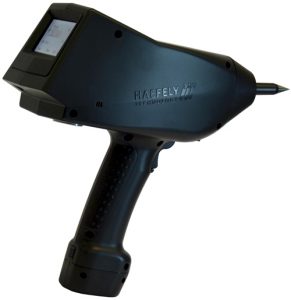Bruno Straumann, Senior Development Engineer,Haefely Test AG Basel, Switzerland.
INTRODUCTION
The new IEC 61000-4-2 Edition 2 standard, which replaces IEC 61000-4-2 Edition 1 1995, was initially announced in December 2008. Based on the revised IEC standard, the identical European standard EN 61000-4-2:2009 was also released. The new EN standard can already be applied for ESD immunity testing, and testing according to the new standard will be mandatory starting 1st of March 2012.
The following article focuses on the effects the new standard has on ESD simulators and the corresponding calibration procedures of such generators.
MISLEADING FIRST IMPRESSIONS

While comparing the previous and new standard ESD simulator specifications, one may easily get the wrong impression. The tolerance levels (Table 1), along with the rise time (tr) and current peak values (Ip), are clearly higher in the new standard. One would assume that the ESD simulator requirements would now be reduced with the new standard, something which is not actually true.
On one hand, the enhanced lower tolerance limit of the rise time only takes into account the lower measurement values, which results from the increased measurement bandwidth. On the other hand, the new standard requires that per measurement level, 5 impulses are recorded at a time and individually evaluated.
Every single measurement (i.e. tr, Ip, I30, I60) of each impulse must meet the required tolerance levels.It is now not permitted to use average values from several impulses, although the previous standard permitted using averaged measured values, a procedure which is often used.
CORRECT MEASUREMENT BECOMES MORE DIFFICULT
Previously, if random measurement errors (in terms of measurement uncertainty) occurred, it was very likely that they would not appear in the final measurement results. The reason for this is because random measurement errors were averaged. With the new standard, random measurement errors are no longer averaged, and thus random errors will now clearly be shown in the final measurement results.
An important source of random measuring errors could be an insufficiently shielded measuring system. In other words, the reason why the measured ESD impulse does not meet the standard specification could be due to the measurement system itself, and not the actual ESD simulator.
Figure 1 shows the possible effects of a badly shielded measurement system.

HIGHER MEASUREMENT BANDWIDTH AND DEFINED TEST SETUP
To calibrate an ESD simulator according to the new standard, the following equipment is necessary:
- Digital Oscilloscope, analogue Bandwidth ≥2GHz / Sampling rate ≥10GS/s
- Measurement target, Bandwidth 4GHz / Impedance ≤2,1 Ohm
- Attenuator, 20dB typically
- Reference ground plane, dimensions ≥ 1,2m x 1,2m
- Suitable shielded housing for the measurement system
First, it is important to note that the new measurement target no longer has the 50 Ohm series resistor. Therefore, when taking measurements of the peak current with the oscilloscope the signal should no longer be cut in half. If data transfer is being performed between a PC and the Oscilloscope it should be done via fiber optics.
A second important aspect of the new test setup is the shielded housing. This has to damp interference frequencies of up to GHz levels and all wiring leading into the shielded housing must be filtered accordingly. A properly shielded scope is even more important when taking measurements according to the new standard. This is because you can no longer average out random errors.
If data transfer is being performed between a PC and the oscilloscope it should be done via fiber optics. Also, the position of the grounding connections on the ground reference plane is now exactly defined; 0.5m vertically below the measuring target.
Finally, the position of the ESD simulator earth cable is now also defined. This is very important and should not be ignored because it influences the measurement values of I30 and I60.
CONSEQUENCES FOR ESD SIMULATORS
Experience shows that there are significant differences between various ESD models. Because the new standard demands more from ESD simulators, it is clear that some ESD simulators will no longer be compliant to the new standard. Testing with such non-compliant ESD simulators can lead to over-testing or under-testing of EUTs. In practice this is not a desirable result.
A decision on whether an existing ESD simulator meets the new requirements can only be made following calibration to the latest edition of the IEC standard. When purchasing a new ESD simulator, one should ensure that the new simulator meets the exact requirements of IEC 61000 4-2 edition 2.

VERIFICATION AND CALIBRATION
In the previous standard, the term verification and calibration was used incorrectly, while the revised standard now correctly differentiates verification from calibration. Calibration is the exact measuring technique of the measurement values, and verification means verification of the ESD simulator. The verification is carried out before the actual testing takes place, whereas calibration period of the ESD simulator needs to be determined by the user, and is typically every 1-2 years.
The new standard suggests that to determine whether the simulator is functioning correctly, the length of the spark should be checked during an air discharge. However, this is an insufficient method as the length of the spark depends on the geometry of the discharging electrodes, the polarity, and the environmental conditions. Furthermore, a defective discharge relay will not be detected. This is the reason modern ESD simulators include self test routines, which within seconds can diagnose potential defects.
It can generally be said that the new IEC/EN 61000-4-2 Edition 2 standard demands more from ESD simulators as well as from the measuring equipment used for calibrating the ESD simulator itself. Whether the ESD simulator meets the standard can only be determined through proper calibration.
BRUNO STRAUMANN is currently working as senior development and application engineer in the EMC Division of HAEFELY. He has been with the company for more than 20 years in various roles, including project manager for design and development of EMC test equipment.
